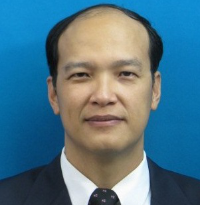
Assistant Professor Weerapun Rungseevijitprapa, Ph.D.
ผศ. ดร.วีระพันธ์ รังสีวิจิตรประภา
Education
- Ph.D. Electrical Engineering, University of Hannover, Germany.
- M.Eng. Electrical Engineering, Chulalongkorn University, Thailand.
- B.Eng. Electrical Engineering Chulalongkorn University, Thailand.
Email: Weerapun.R@chula.ac.th
Research Interest
- High-Voltage Engineering
- Electromagnetic Compatibility
Research Cluster
1.
Singhasathein, A; Rungseevijitprapa, W; Pruksanubal, A
A novel approved mathematical equation for lightning protection angle Journal Article
In: Journal of Electrical Engineering and Technology, vol. 13, no. 2, pp. 1021-1029, 2018, ISSN: 19750102, (cited By 8).
@article{Singhasathein2018a,
title = {A novel approved mathematical equation for lightning protection angle},
author = {A Singhasathein and W Rungseevijitprapa and A Pruksanubal},
url = {https://www.scopus.com/inward/record.uri?eid=2-s2.0-85041801741&doi=10.5370%2fJEET.2018.13.2.1021&partnerID=40&md5=426cf36307a02223330d2902638ea881},
doi = {10.5370/JEET.2018.13.2.1021},
issn = {19750102},
year = {2018},
date = {2018-01-01},
journal = {Journal of Electrical Engineering and Technology},
volume = {13},
number = {2},
pages = {1021-1029},
publisher = {Korean Institute of Electrical Engineers},
abstract = {During the past few decades, the lightning protection angle (α) has been proposed through several technical matters, namely graphical technique, numerical data and mathematical equation respectively. Nevertheless, these techniques are very complicated, and are difficult to utilize because they also contain several constraints practically. Hence, this paper proposes a novel equation of the lightning protection angle, which is a simple correlation, concise and easy to be implemented. Furthermore, the reliable result of this equation can confirm accuracy through comparative analysis with all previous techniques. As a result, these solutions are altogether equivalent. This novel equation can analyze the lightning protection angle of the vertical air termination system installed at the vertex of the royal pagoda in a Khema-pirataram temple which is at high risk due to lightning flashes. © The Korean Institute of Electrical Engineers.},
note = {cited By 8},
keywords = {},
pubstate = {published},
tppubtype = {article}
}
During the past few decades, the lightning protection angle (α) has been proposed through several technical matters, namely graphical technique, numerical data and mathematical equation respectively. Nevertheless, these techniques are very complicated, and are difficult to utilize because they also contain several constraints practically. Hence, this paper proposes a novel equation of the lightning protection angle, which is a simple correlation, concise and easy to be implemented. Furthermore, the reliable result of this equation can confirm accuracy through comparative analysis with all previous techniques. As a result, these solutions are altogether equivalent. This novel equation can analyze the lightning protection angle of the vertical air termination system installed at the vertex of the royal pagoda in a Khema-pirataram temple which is at high risk due to lightning flashes. © The Korean Institute of Electrical Engineers.
2.
Pariyavong, P; RungSeevijitprapa, W
Effective length consideration with the minimize per-unit length impulse impedance method Journal Article
In: IEEJ Transactions on Power and Energy, vol. 128, no. 6, pp. 8+871-878, 2008, ISSN: 03854213, (cited By 1).
@article{Pariyavong2008,
title = {Effective length consideration with the minimize per-unit length impulse impedance method},
author = {P Pariyavong and W RungSeevijitprapa},
url = {https://www.scopus.com/inward/record.uri?eid=2-s2.0-72149122370&doi=10.1541%2fieejpes.128.871&partnerID=40&md5=386e165c52d1d5a2df6d196b99c44c33},
doi = {10.1541/ieejpes.128.871},
issn = {03854213},
year = {2008},
date = {2008-01-01},
journal = {IEEJ Transactions on Power and Energy},
volume = {128},
number = {6},
pages = {8+871-878},
publisher = {Institute of Electrical Engineers of Japan},
abstract = {In practice, sometimes long grounding wires are Applied to decrease the grounding resistance but the lightning performance of the grounding system is still poor because the grounding wires have an effective length. This paper presents an analysis of effective length for horizontal/vertical grounding wires using the minimize per-unit length impulse impedance method. The grounding response due to lightning current was simulated by solving Telegrapher's equations with the finite-difference time-domain (FDTD) technique. During the simulation, the voltage distribution was low enough to limit the electric field intensity not exceeding the critical value for soil ionization, Ec. The results of the simulation were proved with scaling experiments. The simulation analysis showed that the effective length of the horizontal/vertical grounding wires decreases with front time of impulse current. For example, in soil resistivity of 50 ω.m, the effective lengths of the vertical grounding wire are 29 m and 5.3 m for impulse currents of 10/350 μS and 0.25/100 μs, respectively. © 2008 The Institute of Electrical Engineers of Japan.},
note = {cited By 1},
keywords = {},
pubstate = {published},
tppubtype = {article}
}
In practice, sometimes long grounding wires are Applied to decrease the grounding resistance but the lightning performance of the grounding system is still poor because the grounding wires have an effective length. This paper presents an analysis of effective length for horizontal/vertical grounding wires using the minimize per-unit length impulse impedance method. The grounding response due to lightning current was simulated by solving Telegrapher's equations with the finite-difference time-domain (FDTD) technique. During the simulation, the voltage distribution was low enough to limit the electric field intensity not exceeding the critical value for soil ionization, Ec. The results of the simulation were proved with scaling experiments. The simulation analysis showed that the effective length of the horizontal/vertical grounding wires decreases with front time of impulse current. For example, in soil resistivity of 50 ω.m, the effective lengths of the vertical grounding wire are 29 m and 5.3 m for impulse currents of 10/350 μS and 0.25/100 μs, respectively. © 2008 The Institute of Electrical Engineers of Japan.
